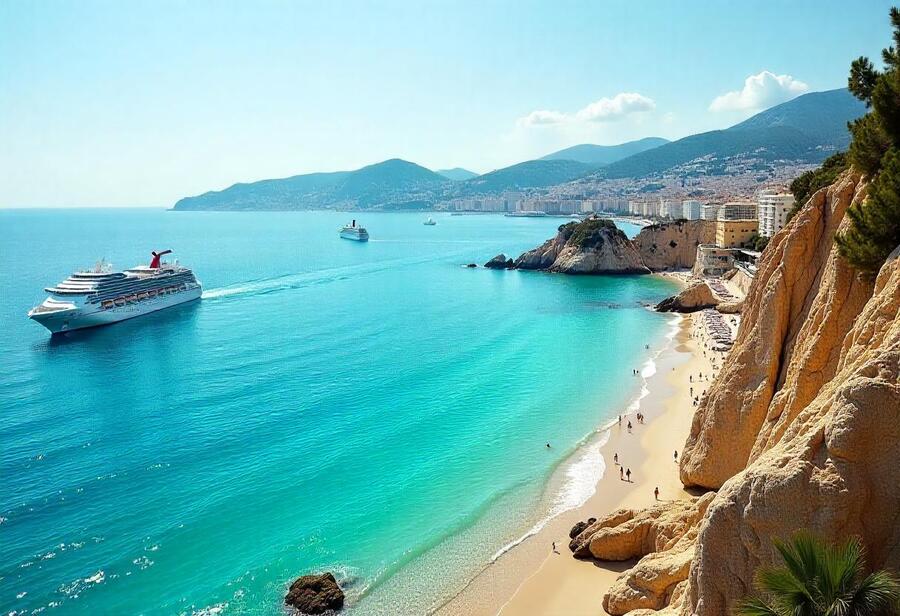European Cities Enforce New Cruise Ship Limits

As European cities increasingly confront the challenges of overtourism, Cannes, a city renowned for its glamorous film festival and Mediterranean coastline, has implemented stringent new cruise ship regulations. These measures aim to mitigate the negative impacts of mass tourism, safeguard local infrastructure, and preserve the city's unique charm and resources for future generations.
Effective January 1, 2026, the Cannes city council has mandated that only cruise ships carrying fewer than 1,000 passengers will be permitted to dock in its port. Furthermore, a daily limit of 6,000 disembarking passengers will be enforced. Vessels exceeding this capacity will be required to transfer their passengers to smaller boats before entering the port. This proactive policy is part of a broader strategy to reduce the environmental footprint of tourism and alleviate the severe congestion that has become increasingly unmanageable in this popular European destination. The new restrictions will take effect shortly before two massive cruise ships, each carrying over 7,000 passengers, are scheduled to dock, representing some of the last vessels of their size to be allowed under the existing rules. Despite backlash from the cruise industry, which foresees negative economic impacts and logistical hurdles for tourists, Cannes remains steadfast in its commitment to sustainable tourism practices.
Cannes is not an isolated case in its pursuit of sustainable tourism. Numerous European cities, including Venice, Barcelona, Amsterdam, and Nice, have already introduced similar restrictions on cruise ships to combat overcrowding and environmental degradation. These collective efforts signify a growing movement across Europe to balance the economic advantages of tourism with the urgent need to protect both the environment and local culture. France, which welcomed a record 100 million visitors in 2024, exceeding its own population, is at the forefront of addressing overtourism. Cities like Cannes, Nice, and Paris are leading initiatives to manage visitor numbers while ensuring that tourism continues to benefit local economies. Specifically, Cannes recognizes the imperative to limit the environmental impact of mass tourism on its natural resources and infrastructure, as the escalating number of visitors has begun to overwhelm the city's capacity for sustainable accommodation.
Overtourism has also manifested as a significant issue in Paris, where workers at the Louvre Museum recently staged a strike. Their protest highlighted concerns about severe overcrowding, inadequate staffing, and the excessive volume of tourists, underscoring the immense strain overtourism places on cultural institutions and public services. Beyond France, protests against the adverse effects of overtourism are widespread. In Venice, activists have voiced strong opposition to the impact of mass tourism on the local populace, particularly in the context of lavish events that symbolize growing wealth inequality. Critics argue that such events exacerbate challenges for residents, who face soaring housing costs and diminished access to essential services, as tourists inundate the area. Venice has long been a key site for discussions surrounding the detrimental effects of tourism on local communities and the environment.
Similarly, in Barcelona, residents have creatively expressed their frustration with mass tourism, including through protests involving water guns, to draw attention to the escalating cost of living driven by the influx of tourists. For many locals, the increased visitor numbers have fundamentally altered the city's character, displacing long-time residents and making housing increasingly unaffordable. These protests serve as a powerful reminder of the inherent tensions between tourism growth and the fundamental needs of local communities. The environmental repercussions of overtourism are also a burgeoning concern, with major European cities experiencing increased pollution levels, overcrowded tourist attractions, and a general degradation of natural environments. As these issues intensify, the demand for more sustainable tourism practices becomes critically urgent, with overcrowding, in particular, placing immense pressure on local ecosystems.
Cannes' decision to restrict the number and size of visiting cruise ships is an integral part of a broader European trend toward responsible and sustainable tourism. By strategically reducing visitor numbers at any given time, cities like Cannes aim to safeguard their distinct cultural identities, preserve their environments, and ensure that tourism continues to benefit both visitors and residents. This approach seeks to establish a crucial balance between welcoming tourists and maintaining the city's integrity for future generations. In conclusion, Cannes' new cruise ship regulations are indicative of a wider movement across Europe where cities are proactively managing tourism more sustainably. As overtourism becomes an increasingly pressing global issue, destinations such as Cannes, Venice, and Barcelona are setting precedents for a future where tourism can flourish without compromising the quality of life for residents or the preservation of the environment. By directly addressing the challenges posed by mass tourism, these cities are ensuring their continued vibrancy and appeal for years to come.












